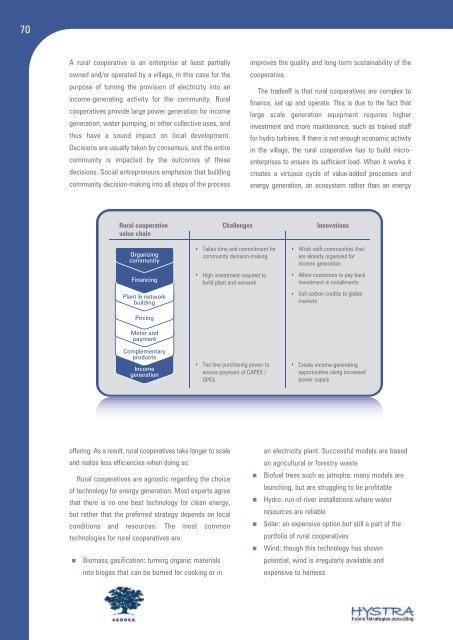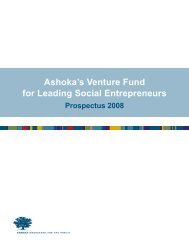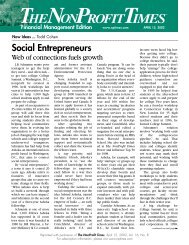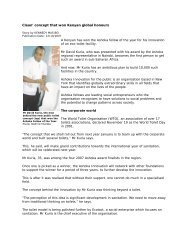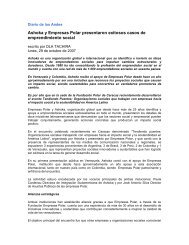Access to Energy for the Base of the - Ashoka
Access to Energy for the Base of the - Ashoka
Access to Energy for the Base of the - Ashoka
Create successful ePaper yourself
Turn your PDF publications into a flip-book with our unique Google optimized e-Paper software.
70<br />
A rural cooperative is an enterprise at least partially<br />
owned and/or operated by a village, in this case <strong>for</strong> <strong>the</strong><br />
purpose <strong>of</strong> turning <strong>the</strong> provision <strong>of</strong> electricity in<strong>to</strong> an<br />
income-generating activity <strong>for</strong> <strong>the</strong> community. Rural<br />
cooperatives provide large power generation <strong>for</strong> income<br />
generation, water pumping, or o<strong>the</strong>r collective uses, and<br />
thus have a sound impact on local development.<br />
Decisions are usually taken by consensus, and <strong>the</strong> entire<br />
community is impacted by <strong>the</strong> outcomes <strong>of</strong> <strong>the</strong>se<br />
decisions. Social entrepreneurs emphasize that building<br />
community decision-making in<strong>to</strong> all steps <strong>of</strong> <strong>the</strong> process<br />
Rural cooperative<br />
value chain<br />
Organizing<br />
community<br />
Financing<br />
Plant & network<br />
building<br />
Pricing<br />
Meter and<br />
payment<br />
Complementary<br />
products<br />
Income<br />
generation<br />
<strong>of</strong>fering. As a result, rural cooperatives take longer <strong>to</strong> scale<br />
and realize less efficiencies when doing so.<br />
Rural cooperatives are agnostic regarding <strong>the</strong> choice<br />
<strong>of</strong> technology <strong>for</strong> energy generation. Most experts agree<br />
that <strong>the</strong>re is no one best technology <strong>for</strong> clean energy,<br />
but ra<strong>the</strong>r that <strong>the</strong> preferred strategy depends on local<br />
conditions and resources. The most common<br />
technologies <strong>for</strong> rural cooperatives are:<br />
� Biomass gasification: turning organic materials<br />
in<strong>to</strong> biogas that can be burned <strong>for</strong> cooking or in<br />
�<br />
�<br />
�<br />
improves <strong>the</strong> quality and long-term sustainability <strong>of</strong> <strong>the</strong><br />
cooperative.<br />
The trade<strong>of</strong>f is that rural cooperatives are complex <strong>to</strong><br />
finance, set up and operate. This is due <strong>to</strong> <strong>the</strong> fact that<br />
large scale generation equipment requires higher<br />
investment and more maintenance, such as trained staff<br />
<strong>for</strong> hydro turbines. If <strong>the</strong>re is not enough economic activity<br />
in <strong>the</strong> village, <strong>the</strong> rural cooperative has <strong>to</strong> build microenterprises<br />
<strong>to</strong> ensure its sufficient load. When it works it<br />
creates a virtuous cycle <strong>of</strong> value-added processes and<br />
energy generation, an ecosystem ra<strong>the</strong>r than an energy<br />
Challenges Innovations<br />
Takes time and commitment <strong>for</strong><br />
community decision-making<br />
High investment required <strong>to</strong><br />
build plant and network<br />
Too low purchasing power <strong>to</strong><br />
ensure payment <strong>of</strong> CAPEX /<br />
OPEX<br />
�<br />
�<br />
�<br />
�<br />
Work with communities that<br />
are already organized <strong>for</strong><br />
income generation<br />
Allow cus<strong>to</strong>mers <strong>to</strong> pay back<br />
investment in installments<br />
Sell carbon credits <strong>to</strong> global<br />
markets<br />
Create income-generating<br />
opportunities using increased<br />
power supply<br />
an electricity plant. Successful models are based<br />
on agricultural or <strong>for</strong>estry waste<br />
� Bi<strong>of</strong>uel trees such as jatropha: many models are<br />
launching, but are struggling <strong>to</strong> be pr<strong>of</strong>itable<br />
� Hydro: run-<strong>of</strong>-river installations where water<br />
resources are reliable<br />
� Solar: an expensive option but still a part <strong>of</strong> <strong>the</strong><br />
portfolio <strong>of</strong> rural cooperatives<br />
� Wind: though this technology has shown<br />
potential, wind is irregularly available and<br />
expensive <strong>to</strong> harness


